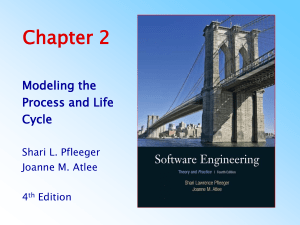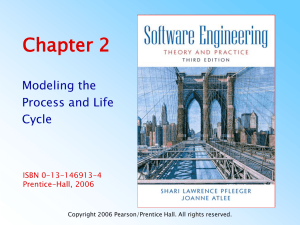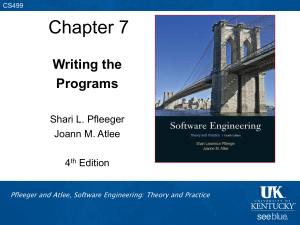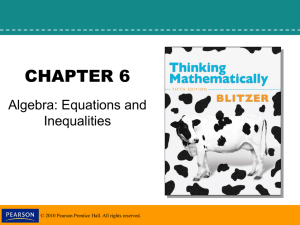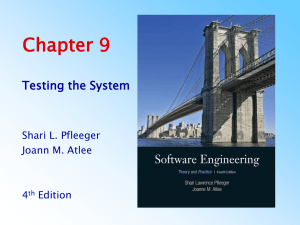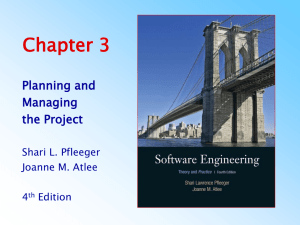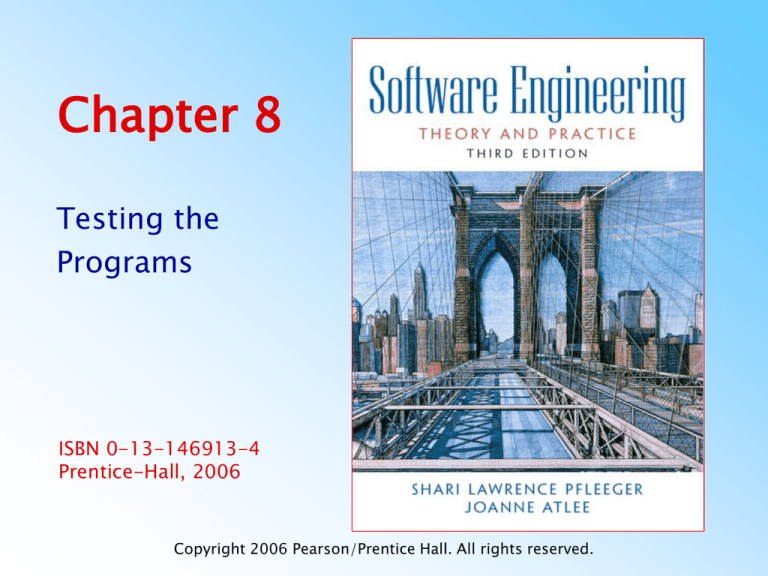
Chapter 8
Testing the
Programs
ISBN 0-13-146913-4
Prentice-Hall, 2006
Copyright 2006 Pearson/Prentice Hall. All rights reserved.
Contents
8.1
8.2
8.3
8.4
8.5
8.6
8.7
8.8
8.9
8.10
8.11
Software Faults and Failures
Testing Issues
Unit Testing
Integration Testing
Testing Object-Oriented Systems
Test Planning
Automated Testing Tools
When to Stop Testing
Information System Example
Real Time Example
What this Chapter Means for You
Pfleeger and Atlee, Software Engineering: Theory and Practice
© 2006 Pearson/Prentice Hall
Page 8.2
Chapter 8 Objectives
• Types of faults and how to classify them
• The purpose of testing
• Unit testing
• Integration testing strategies
• Test planning
• When to stop testing
Pfleeger and Atlee, Software Engineering: Theory and Practice
© 2006 Pearson/Prentice Hall
Page 8.3
8.1 Software Faults and Failures
Why Does Software Fail?
• Wrong requirement: not what the customer
wants
• Missing requirement
• Requirement impossible to implement
• Faulty design
• Faulty code
• Improperly implemented design
Pfleeger and Atlee, Software Engineering: Theory and Practice
© 2006 Pearson/Prentice Hall
Page 8.4
8.1 Software Faults and Failures
Objective of Testing
• Objective of testing: discover faults
• A test is successful only when a fault is
discovered
– Fault identification is the process of determining
what fault caused the failure
– Fault correction is the process of making changes
to the system so that the faults are removed
Pfleeger and Atlee, Software Engineering: Theory and Practice
© 2006 Pearson/Prentice Hall
Page 8.5
8.1 Software Faults and Failures
Types of Faults
• Algorithmic fault
• Computation and precision fault
– a formula’s implementation is wrong
• Documentation fault
– Documentation doesn’t match what program does
• Capacity or boundary faults
– System’s performance not acceptable when certain limits
are reached
• Timing or coordination faults
• Performance faults
– System does not perform at the speed prescribed
• Standard and procedure faults
Pfleeger and Atlee, Software Engineering: Theory and Practice
© 2006 Pearson/Prentice Hall
Page 8.6
8.1 Software Faults and Failures
Typical Algorithmic Faults
• An algorithmic fault occurs when a
component’s algorithm or logic does not
produce proper output
–
–
–
–
Branching too soon
Branching too late
Testing for the wrong condition
Forgetting to initialize variable or set loop
invariants
– Forgetting to test for a particular condition
– Comparing variables of inappropriate data types
• Syntax faults
Pfleeger and Atlee, Software Engineering: Theory and Practice
© 2006 Pearson/Prentice Hall
Page 8.7
8.1 Software Faults and Failures
Orthogonal Defect Classification
Fault Type
Meaning
Function
Fault that affects capability, end-user interface, product
interface with hardware architecture, or global data
structure
Interface
Fault in interacting with other component or drivers via
calls, macros, control blocks, or parameter lists
Checking
Fault in program logic that fails to validate data and
values properly before they are used
Assignment
Fault in data structure or code block initialization
Timing/serialization
Fault in timing of shared and real-time resources
Build/package/merge
Fault that occurs because of problems in repositories,
management changes, or version control
Documentation
Fault that affects publications and maintenance notes
Algorithm
Fault involving efficiency or correctness of algorithm or
data structure but not design
Pfleeger and Atlee, Software Engineering: Theory and Practice
© 2006 Pearson/Prentice Hall
Page 8.8
8.1 Software Faults and Failures
Sidebar 8.1 Hewlett-Packard’s Fault Classification
Pfleeger and Atlee, Software Engineering: Theory and Practice
© 2006 Pearson/Prentice Hall
Page 8.9
8.1 Software Faults and Failures
Sidebar 8.1 Faults for one Hewlett-Packard Division
Pfleeger and Atlee, Software Engineering: Theory and Practice
© 2006 Pearson/Prentice Hall
Page 8.10
8.2 Testing Issues
Testing Organization
• Module testing, component testing, or unit
testing
• Integration testing
• Function testing
• Performance testing
• Acceptance testing
• Installation testing
Pfleeger and Atlee, Software Engineering: Theory and Practice
© 2006 Pearson/Prentice Hall
Page 8.11
8.2 Testing Issues
Testing Organization Illustrated
Pfleeger and Atlee, Software Engineering: Theory and Practice
© 2006 Pearson/Prentice Hall
Page 8.12
8.2 Testing Issues
Attitude Toward Testing
• Egoless programming: programs are viewed
as components of a larger system, not as the
property of those who wrote them
Pfleeger and Atlee, Software Engineering: Theory and Practice
© 2006 Pearson/Prentice Hall
Page 8.13
8.2 Testing Issues
Who Performs the Test?
• Independent test team
– avoid conflict
– improve objectivity
– allow testing and coding concurrently
Pfleeger and Atlee, Software Engineering: Theory and Practice
© 2006 Pearson/Prentice Hall
Page 8.14
8.2 Testing Issues
Views of the Test Objects
• Closed box or black box: functionality of the
test objects
• Clear box or white box: structure of the test
objects
Pfleeger and Atlee, Software Engineering: Theory and Practice
© 2006 Pearson/Prentice Hall
Page 8.15
8.2 Testing Issues
White Box
• Advantage
– free of internal structure’s constraints
• Disadvantage
– not possible to run a complete test
Pfleeger and Atlee, Software Engineering: Theory and Practice
© 2006 Pearson/Prentice Hall
Page 8.16
8.2 Testing Issues
Clear Box
• Example of logic structure
Pfleeger and Atlee, Software Engineering: Theory and Practice
© 2006 Pearson/Prentice Hall
Page 8.17
8.2 Testing Issues
Sidebar 8.2 Box Structures
• Black box: external behavior description
• State box: black box with state information
• White box: state box with a procedure
Pfleeger and Atlee, Software Engineering: Theory and Practice
© 2006 Pearson/Prentice Hall
Page 8.18
8.2 Testing Issues
Factors Affecting the Choice of Test Philosophy
• The
• The
• The
• The
number of possible logical paths
nature of the input data
amount of computation involved
complexity of algorithms
Pfleeger and Atlee, Software Engineering: Theory and Practice
© 2006 Pearson/Prentice Hall
Page 8.19
8.3 Unit Testing
Code Review
• Code walkthrough
• Code inspection
Pfleeger and Atlee, Software Engineering: Theory and Practice
© 2006 Pearson/Prentice Hall
Page 8.20
8.3 Unit Testing
Typical Inspection Preparation and Meeting Times
Development Artifact
Preparation Time
Meeting Time
Requirement Document
25 pages per hour
12 pages per hour
Functional specification
45 pages per hour
15 pager per hour
Logic specification
50 pages per hour
20 pages per hour
Source code
150 lines of code per
hour
75 lines of code per
hour
User documents
35 pages per hour
20 pages per hour
Pfleeger and Atlee, Software Engineering: Theory and Practice
© 2006 Pearson/Prentice Hall
Page 8.21
8.3 Unit Testing
Sidebar 8.3 The Best Team Size for Inspections
• The preparation rate, not the team size,
determines inspection effectiveness
• The team’s effectiveness and efficiency
depend on their familiarity with their product
Pfleeger and Atlee, Software Engineering: Theory and Practice
© 2006 Pearson/Prentice Hall
Page 8.23
8.3 Unit Testing
Proving Code Correct
• Formal proof techniques
• Symbolic execution
• Automated theorem-proving
Pfleeger and Atlee, Software Engineering: Theory and Practice
© 2006 Pearson/Prentice Hall
Page 8.24
8.3 Unit Testing
Proving Code Correct: An Illustration
Pfleeger and Atlee, Software Engineering: Theory and Practice
© 2006 Pearson/Prentice Hall
Page 8.25
8.3 Unit Testing
Testing versus Proving
• Proving: hypothetical environment
• Testing: actual operating environment
Pfleeger and Atlee, Software Engineering: Theory and Practice
© 2006 Pearson/Prentice Hall
Page 8.26
8.3 Unit Testing
Steps in Choosing Test Cases
• Determining test objectives
• Selecting test cases
• Defining a test
Pfleeger and Atlee, Software Engineering: Theory and Practice
© 2006 Pearson/Prentice Hall
Page 8.27
8.3 Unit Testing
Test Thoroughness
• Statement testing
• Branch testing
• Path testing
• Definition-use testing
• All-uses testing
• All-predicate-uses/some-computationaluses testing
• All-computational-uses/some-predicateuses testing
Pfleeger and Atlee, Software Engineering: Theory and Practice
© 2006 Pearson/Prentice Hall
Page 8.28
8.3 Unit Testing
Relative Strengths of Test Strategies
Pfleeger and Atlee, Software Engineering: Theory and Practice
© 2006 Pearson/Prentice Hall
Page 8.29
8.3 Unit Testing
Comparing Techniques
• Fault discovery Percentages by Fault Origin
Discovery Techniques
Requirements
Design
Coding
Documentation
Prototyping
40
35
35
15
Requirements review
40
15
0
5
Design Review
15
55
0
15
Code inspection
20
40
65
25
1
5
20
0
Unit testing
Pfleeger and Atlee, Software Engineering: Theory and Practice
© 2006 Pearson/Prentice Hall
Page 8.30
8.3 Unit Testing
Comparing Techniques (continued)
• Effectiveness of fault-discovery techniques
Requirements
Faults
Design Faults
Code Faults
Documentation
Faults
Fair
Excellent
Excellent
Good
Prototypes
Good
Fair
Fair
Not applicable
Testing
Poor
Poor
Good
Fair
Correctness Proofs
Poor
Poor
Fair
Fair
Reviews
Pfleeger and Atlee, Software Engineering: Theory and Practice
© 2006 Pearson/Prentice Hall
Page 8.31
8.3 Unit Testing
Sidebar 8.4 Fault Discovery Efficiency at Contel IPC
• 17.3% during inspections of the system
design
• 19.1% during component design inspection
• 15.1% during code inspection
• 29.4% during integration testing
• 16.6% during system and regression testing
• 0.1% after the system was placed in the field
Pfleeger and Atlee, Software Engineering: Theory and Practice
© 2006 Pearson/Prentice Hall
Page 8.32
8.4 Integration Testing
•
•
•
•
•
•
Bottom-up
Top-down
Big-bang
Sandwich testing
Modified top-down
Modified sandwich
Pfleeger and Atlee, Software Engineering: Theory and Practice
© 2006 Pearson/Prentice Hall
Page 8.33
8.4 Integration Testing
Terminology
• Component Driver: a routine that calls a
particular component and passes a test case
to it
• Stub: a special-purpose program to
simulate the activity of the missing
component
Pfleeger and Atlee, Software Engineering: Theory and Practice
© 2006 Pearson/Prentice Hall
Page 8.34
8.4 Integration Testing
View of a System
• System viewed as a hierarchy of components
Pfleeger and Atlee, Software Engineering: Theory and Practice
© 2006 Pearson/Prentice Hall
Page 8.35
8.4 Integration Testing
Bottom-Up Integration Example
• The sequence of tests and their
dependencies
Pfleeger and Atlee, Software Engineering: Theory and Practice
© 2006 Pearson/Prentice Hall
Page 8.36
8.4 Integration Testing
Top-Down Integration Example
• Only A is tested by itself
Pfleeger and Atlee, Software Engineering: Theory and Practice
© 2006 Pearson/Prentice Hall
Page 8.37
8.4 Integration Testing
Big-Bang Integration Example
• Requires both stubs and drivers to test the
independent components
Pfleeger and Atlee, Software Engineering: Theory and Practice
© 2006 Pearson/Prentice Hall
Page 8.39
8.4 Integration Testing
Sandwich Integration Example
• Viewed system as three layers
Pfleeger and Atlee, Software Engineering: Theory and Practice
© 2006 Pearson/Prentice Hall
Page 8.40
8.4 Integration Testing
Sidebar 8.5 Builds at Microsoft
• The feature teams synchronize their work by building the
product and finding and fixing faults on a daily basis
Pfleeger and Atlee, Software Engineering: Theory and Practice
© 2006 Pearson/Prentice Hall
Page 8.43
8.6 Test Planning
•
•
•
•
•
•
Establish test objectives
Design test cases
Write test cases
Test test cases
Execute tests
Evaluate test results
Pfleeger and Atlee, Software Engineering: Theory and Practice
© 2006 Pearson/Prentice Hall
Page 8.47
8.6 Test Planning
Purpose of the Plan
• Test plan explains
–
–
–
–
who does the testing
why the tests are performed
how tests are conducted
when the tests are scheduled
Pfleeger and Atlee, Software Engineering: Theory and Practice
© 2006 Pearson/Prentice Hall
Page 8.48
8.6 Test Planning
Contents of the Plan
• What the test objectives are
• How the test will be run
• What criteria will be used to determine when
the testing is complete
Pfleeger and Atlee, Software Engineering: Theory and Practice
© 2006 Pearson/Prentice Hall
Page 8.49
8.8 When to Stop Testing
More faulty?
• Probability of finding faults during
the development
Pfleeger and Atlee, Software Engineering: Theory and Practice
© 2006 Pearson/Prentice Hall
Page 8.52
8.11 What this Chapter Means for You
• It is important to understand the difference
between faults and failures
• The goal of testing is to find faults, not to
prove correctness
Pfleeger and Atlee, Software Engineering: Theory and Practice
© 2006 Pearson/Prentice Hall
Page 8.58

